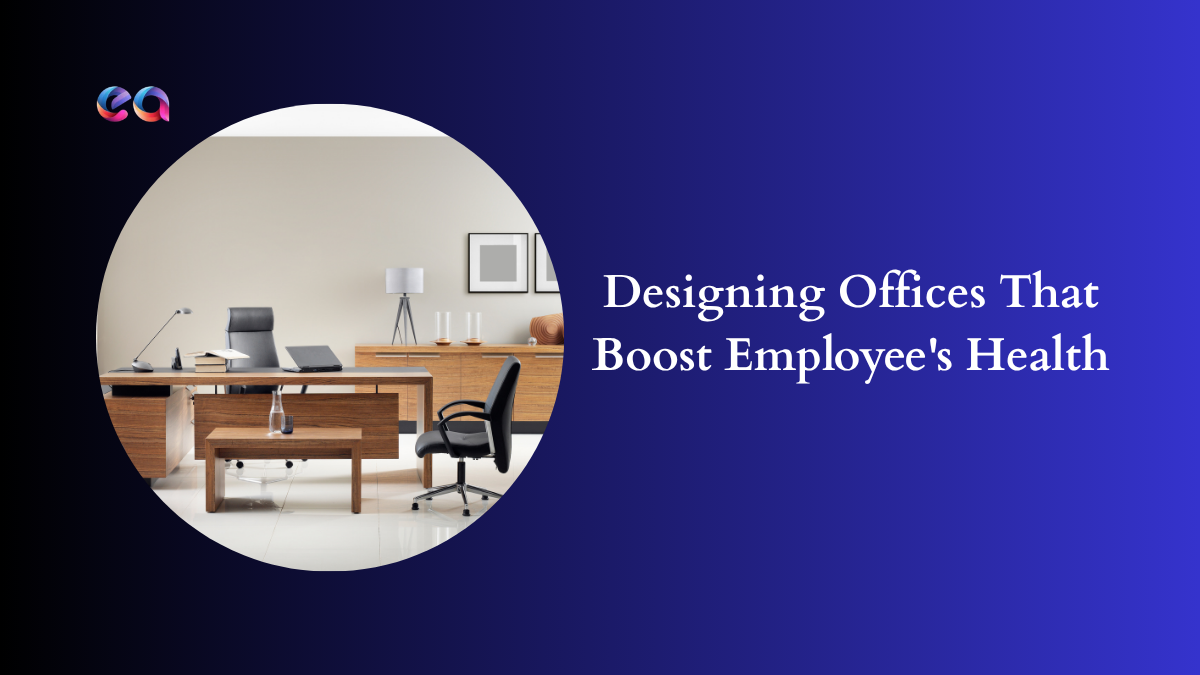
The traditional office, often characterized by sterile walls, harsh artificial lighting, and rows of uniform desks, is undergoing a profound transformation. No longer viewed merely as a place for task completion, the modern workplace is increasingly recognized as a critical determinant of employee well-being, and consequently, business success. The understanding has dawned that office design transcends mere aesthetics or spatial efficiency; it stands as a potent strategic instrument for cultivating employee health, enhancing productivity, and fostering engagement. This evolution marks a fundamental shift towards designing offices that place worker wellness at the forefront – a movement driven not by fleeting trends, but by a growing body of compelling evidence.
The financial implications of this shift are significant. Staff costs, including salaries and benefits, typically account for approximately 90% of business operating costs. Therefore, even modest improvements in employee performance and well-being, facilitated by superior office design, can yield substantial financial returns for an organization. This realization elevates workplace design from a secondary consideration to a core business strategy, pivotal for sustained success. The sheer volume of research and the increasing focus on this topic underscore its mainstream relevance to business leaders and HR professionals alike.
This article serves as a comprehensive guide to understanding and implementing wellness-first office design. Drawing upon scientific research, expert analyses, and real-world case studies, it will explore the core principles of creating healthier work environments. The aim is to demonstrate how a thoughtful investment in employee well-being through strategic design is not only a moral imperative but also a sound investment in the future vitality and prosperity of any organization. The move towards wellness-centric workplaces is also a proactive response to the growing awareness of the preventable negative impacts stemming from poorly conceived office environments. Many historical design choices, such as inadequate ventilation leading to headaches or harsh fluorescent lighting causing discomfort, have known detrimental effects on both health and productivity. The wellness revolution in office design, therefore, is as much about mitigating these established harms as it is about introducing new, positive features, reflecting a more mature, evidence-based approach to creating spaces where employees can truly thrive.
Table of Contents
The Science-Backed Pillars of a Wellness-First Office Design
Creating an office that genuinely prioritizes worker wellness involves a multi-faceted approach, grounded in scientific understanding of how physical environments impact human health, mood, and performance. Several key pillars form the foundation of such a design philosophy.
A. The Illuminating Power of Light: Beyond Simple Brightness
Light, in its various forms, is arguably one of the most critical environmental factors influencing well-being and productivity in the workplace. Its impact extends far beyond mere visibility, affecting physiological rhythms, mood, and cognitive function.
Natural light stands as a paramount consideration in wellness-focused office design. Maximizing its ingress through thoughtful architectural features such as large windows, skylights, and light tubes can yield profound benefits. Employees with access to natural light and views of the outdoors consistently report higher levels of satisfaction and well-being. Research indicates that workers in offices with windows receive 173% more exposure to natural white light during work hours and, remarkably, enjoy an average of 46 minutes more sleep per night. This enhanced sleep quality is directly linked to improved mood, increased alertness, better concentration, and higher overall job satisfaction. Furthermore, exposure to natural light helps regulate the body’s circadian rhythms, alleviates physical eye strain, and has been associated with reduced stress levels and fewer sick days. The emphasis on natural light is not just about aesthetic appeal or energy savings; it directly influences fundamental physiological processes that underpin employee performance. This creates a positive feedback loop where better environmental quality leads to better health, which in turn supports higher productivity.
When natural light is insufficient, the quality and control of artificial lighting become crucial. Modern LED technology offers significant advantages over traditional systems, allowing for dynamic adjustments in intensity and color temperature based on available natural daylight and specific task requirements. This contrasts sharply with the issues posed by older fluorescent lighting, often characterized by harsh glare, uncomfortable brightness, and even potential UV radiation exposure. Optimal artificial lighting strategies incorporate appropriate illuminance levels, effective glare control, and the ability to adjust color temperature to support various work activities and even employee circadian rhythms. Crucially, providing occupants with a degree of control over their local lighting environment, through task lighting and manual overrides, is key to satisfaction and comfort. A one-size-fits-all approach to lighting is often suboptimal, as individual preferences and task needs vary. Empowering employees to adjust their lighting contributes significantly to their comfort and ability to focus.
B. Nature’s Embrace: Biophilic Design in the Modern Office
Biophilic design is a concept rooted in the innate human tendency to connect with nature and natural processes. It involves the deliberate integration of natural elements, forms, and patterns into the built environment to enhance human health and well-being. This goes beyond simply adding a few potted plants; it’s a holistic design philosophy that seeks to create restorative and stimulating indoor spaces.
The benefits of incorporating biophilic design principles in the workplace are extensive and well-documented. Exposure to natural elements has been shown to significantly reduce stress and anxiety, partly by lowering cortisol levels and triggering calming neural responses. Cognitive functions such as attention, focus, memory, and creativity are also enhanced in biophilic environments. Consequently, this often translates into increased productivity and reduced absenteeism. For instance, a global study by Interface found that employees in settings with natural elements reported 15% higher well-being, were 6% more productive, and 15% more creative. Some biophilic elements, like indoor plants, can also contribute to improved indoor air quality.
Practical implementation of biophilic design can take many forms. These include the incorporation of living walls, strategically placed indoor plants, maximizing natural light and providing views of nature. Other elements involve the use of natural materials like wood and stone, the inclusion of water features, and the application of nature-inspired art and patterns. The aim is to create a multi-sensory experience that mimics the richness and restorative qualities of the natural world. However, it’s important to note that the effectiveness of biophilic interventions can vary. While elements like substantial greenery and direct views of nature tend to have large positive effects, some simulated natural elements or isolated features like small water features may have smaller impacts if not part of a comprehensive strategy. This underscores the need for thoughtful, evidence-based application rather than a tokenistic approach. The synergy between different wellness strategies can also amplify benefits; for example, natural light supports plant growth, and plants can help diffuse light, creating a more comfortable overall environment.
C. Ergonomics: The Architecture of Comfort and Health
Ergonomics in the workplace is the science of designing the job, equipment, and workplace to fit the worker, thereby reducing physical strain, improving comfort, and preventing musculoskeletal disorders (MSDs). A well-designed ergonomic environment is fundamental to employee health and sustained productivity.
Key ergonomic elements in an office setting include adjustable chairs that offer proper lumbar support, sit-stand desks that allow employees to vary their posture throughout the day, appropriately positioned keyboard trays, and monitor stands that ensure screens are at eye level. Beyond static furniture, ergonomic design also encompasses promoting movement, whether through the layout of the office or the provision of active workstations. The physical health benefits are clear: a significant reduction in the risk of repetitive strain injuries, back pain, neck strain, and other MSDs that can lead to chronic discomfort and absenteeism. Research suggests that businesses investing in ergonomic design can experience a 15% increase in productivity.
The principles of ergonomics are increasingly focused on dynamic and personalized solutions. The rise of adjustable furniture like sit-stand desks reflects a shift away from a single “correct” posture towards enabling movement and allowing individuals to tailor their immediate workspace to their specific physical needs and the tasks at hand throughout the day. This adaptability is crucial for long-term comfort and health.
The recent widespread shift to remote and hybrid work models has further underscored the importance of ergonomics. Many employees working from home initially used makeshift setups not designed for prolonged work, leading to increased reports of discomfort, particularly in the neck, back, and wrists. This experience has heightened awareness that proper ergonomic support is a necessity, not a luxury, for sustained and healthy work, prompting companies to invest in resources and stipends for home office setups and to integrate ergonomic assessments into remote work policies. Investing in ergonomics provides clear preventative health benefits, which translate into direct and indirect cost savings for businesses through reduced sick days, lower healthcare expenses, and fewer workers’ compensation claims.
11 Living Room Decor Ideas That Won’t Break the Bank
D. The Air We Breathe: Championing Air Quality and Ventilation
Indoor Air Quality (IAQ) is an often-overlooked yet profoundly impactful component of a healthy and productive office environment. The air employees breathe directly affects their respiratory health, cognitive function, and overall energy levels. Common indoor pollutants include carbon dioxide (CO2) exhaled by occupants, Volatile Organic Compounds (VOCs) off-gassed from building materials, furniture, and cleaning agents, as well as dust, allergens, and airborne pathogens.
Poor IAQ can lead to a range of negative outcomes, from acute symptoms like headaches, fatigue, lethargy, and irritation of the eyes, nose, and throat (often termed Sick Building Syndrome symptoms) to more serious long-term respiratory conditions such as asthma. Crucially, poor IAQ significantly impairs cognitive abilities. Landmark research, such as the Harvard COGfx studies, has demonstrated that employees in environments with enhanced ventilation and lower levels of pollutants like CO2 and VOCs perform substantially better on cognitive tasks. In some controlled settings, cognitive function scores doubled or even nearly tripled under “green” building conditions with optimized ventilation compared to conventional office environments. Other studies have shown workers in green-certified buildings scoring 26.4% higher on cognitive function tests. The World Green Building Council also reports that better indoor air quality can lead to productivity improvements of 8-11%. These findings highlight that improving IAQ is a high-impact intervention for boosting brainpower and work output.
Strategies for improving IAQ are multifaceted. Proper ventilation is paramount, ensuring a consistent supply of fresh outdoor air and the effective removal of indoor pollutants. This includes adhering to or exceeding standards like those from OSHA, with optimal ventilation rates often suggested to be between 20 and 30 liters per second per person. The use of high-efficiency particulate air (HEPA) filters in HVAC systems and standalone air purifiers can effectively remove particulate matter, allergens, and other airborne contaminants. Source control is also critical; this involves selecting low-VOC building materials, furnishings, and cleaning products to minimize the off-gassing of harmful chemicals. Indoor plants can also play a modest role in air purification and offer biophilic benefits. Regular maintenance of HVAC systems is essential to ensure they operate efficiently and effectively.
The economic case for investing in IAQ improvements is compelling. The Harvard COGfx study estimated that doubling ventilation rates in typical office buildings could yield productivity gains valued at an average of $6,500 per person per year, for an annual energy cost of only $14 to $40 per person. This demonstrates a remarkable return on investment, firmly positioning IAQ as a critical strategic consideration for any organization aiming to optimize employee performance and well-being.
E. The Sound of Silence (and Productive Buzz): Mastering Office Acoustics
The acoustic environment of an office profoundly influences employee concentration, stress levels, and overall satisfaction. Unwanted noise is a common and significant distractor in many workplaces, particularly in open-plan settings, leading to reduced productivity and heightened stress. Indeed, studies show that a lack of speech privacy is one of the greatest sources of dissatisfaction among office workers, with as many as 70% of employees reporting being distracted by office noise.
The impact of noise extends to cognitive performance, impairing tasks such as reading comprehension, proofreading, and memory. Research has indicated a potential 66% drop in performance on memory-related tasks when individuals are exposed to typical background office noise. Interestingly, the relationship between sound level and physiological well-being is not linear; research suggests that an optimal sound level hovers around 50 dBA (A-weighted decibels), roughly equivalent to a quiet refrigerator. Environments that are excessively quiet or overly loud can both negatively impact well-being. This implies that the goal of acoustic design is not absolute silence but the creation of an appropriate and controlled soundscape conducive to various work activities.
Effective acoustic management involves a combination of strategies, often summarized by the “ABCDs” of acoustics :
- Absorb: Utilizing materials that soak up sound, such as highly absorptive ceiling tiles, carpeted floors, acoustic wall panels, and soft furnishings.
- Block: Preventing sound from traveling between spaces using physical barriers like demountable walls, suspended ceiling tiles, and strategically placed private booths or pods for focused work or confidential calls.
- Cover: Introducing unobtrusive background sound, often referred to as sound masking (e.g., white noise or pink noise), to make intrusive speech less intelligible and reduce distractions. Advanced systems, like the Moodsonic soundscape system implemented at GSK, use natural, non-repetitive sounds that can adapt to circadian rhythms and even cater to neurodiverse needs.
- Diffuse: Scattering sound energy evenly within a space using specially designed sound-dispersing elements on walls or ceilings to prevent harsh echoes and create a more balanced acoustic environment.
Beyond these physical interventions, establishing cultural norms such as designated quiet zones and respecting quiet hours for focused work can also contribute significantly to a better acoustic environment. The increasing prevalence of hybrid work models and video conferencing has further amplified the need for excellent acoustic design. “Teams Ready” rooms and soundproofed phone booths are becoming essential to ensure that virtual meetings do not disrupt those working on focused tasks in more open areas. Thoughtful acoustic design is also a key component of neuro-inclusive workplaces, accommodating individuals with varying sensory sensitivities and creating more comfortable and productive environments for all.
F. Space That Empowers: Optimizing Office Layouts for Wellness and Flexibility
Office layout plays a pivotal role in shaping employee experience, influencing collaboration, concentration, movement, and overall well-being. The long-standing debate between open-plan offices and more traditional cellular or private office arrangements continues, with research presenting a nuanced picture. While open-plan designs are often touted for fostering collaboration and transparency , they frequently face criticism for excessive noise, constant distractions, a lack of privacy, and consequently, increased stress levels and even a higher incidence of sick days. Some studies have even suggested that open-plan environments can paradoxically lead to a decrease in meaningful face-to-face interactions as employees resort to electronic communication to avoid disruption.
The emerging consensus points towards hybrid and activity-based working (ABW) environments as a more effective solution. This approach emphasizes providing a diverse ecosystem of spaces tailored to different tasks and work styles. Such layouts typically include a mix of zones for focused individual work, collaborative team projects, informal social interactions, private calls or meetings, and dedicated areas for relaxation and rejuvenation. Key elements of these flexible layouts include modular furniture that can be easily reconfigured, movable walls or partitions, designated quiet zones, comfortable breakout areas, wellness rooms, touchdown spaces for occasional office users, and options for hot-desking.
A critical factor in the success of any office layout is the degree of choice and control it affords employees over their immediate environment. When employees can select a workspace that best suits their current task and personal preferences, satisfaction and productivity tend to increase. Moreover, office layout can be strategically designed to encourage physical movement, for instance, by centralizing amenities like printers or coffee stations, or by making staircases more attractive and accessible than elevators.
However, the shift to flexible models like ABW is not without its challenges. Recent critiques highlight that ABW can fail if it is not thoughtfully implemented in alignment with specific task characteristics and organizational culture. For example, if there is a shortage of quiet spaces for concentration or confidential work, or if the design doesn’t allow for necessary personalization for creative tasks, employee well-being and productivity can suffer. The psychological impact of layout, particularly concerning perceived privacy and control, often outweighs the physical arrangement itself. If employees feel constantly exposed, monitored, or unable to adapt their surroundings, their sense of well-being and ability to perform effectively will be compromised, regardless of how aesthetically pleasing or “flexible” the space appears. Thus, “flexibility” must encompass a true diversity of space types that cater to varied psychological and work-related needs, moving beyond mere reconfigurable furniture to offer genuine choice and support for different modes of work.
The Tangible Returns: ROI of Investing in a Wellness-Focused Office
Investing in a wellness-first office design is increasingly understood not as a mere expenditure but as a strategic imperative with a demonstrable return on investment (ROI). The benefits manifest across several key business metrics, including enhanced productivity, reduced operational costs through lower absenteeism and healthcare expenses, and improved talent attraction and retention.
Increased Productivity & Performance: The link between a well-designed office environment and employee productivity is strongly supported by quantitative data. The Harvard COGfx studies, for example, found that cognitive function scores—critical for knowledge work—could double or even triple in environments with enhanced indoor air quality (IAQ) and optimal ventilation compared to conventional buildings. Green-certified offices were also associated with 26.4% higher cognitive scores. The World Green Building Council (WorldGBC) corroborates these findings, reporting productivity improvements of 8-11% stemming from better IAQ alone, and additional single-digit improvements from providing occupants with control over thermal comfort.
Biophilic design, the integration of natural elements, has been shown by Interface’s Human Spaces Report to increase productivity by 6%. The American Society of Interior Designers (ASID) headquarters, a WELL Platinum certified space, reported a 16% increase in presenteeism, with employees working at 90% of their possible job performance. Similarly, a large-scale peer-reviewed study on WELL Certified spaces published in Building & Environment found a 10 median point jump in productivity scores. Ergonomic design alone can contribute to a productivity increase of up to 15%. These direct impacts on cognitive output and task efficiency translate into significant financial gains, particularly in industries reliant on focused, creative, and analytical work.
Reduced Absenteeism & Healthcare Costs: A healthier work environment naturally leads to a healthier workforce. Improved IAQ, a cornerstone of wellness design, has been linked to 35% lower short-term sick leave in offices with better ventilation. Access to daylight and views of nature explained 6.5% of the variation in sick leave in one study , while biophilic design, more broadly, has been associated with 18% fewer sick days. Skanska UK, for instance, saved £28,000 in absenteeism costs in a single year due to 3.5 times fewer building-related sick days in their green office. The ASID HQ saw absenteeism scores improve by 19% post-WELL certification.
Beyond absenteeism, there’s evidence of direct healthcare cost savings. One Harvard study indicated that for every dollar spent on comprehensive wellness programs (which often include environmental improvements), medical costs can fall by $3.27 and absentee costs by $2.73. WELL Certified offices have also reported 12% lower Sick Building Syndrome complaints , further reducing health-related disruptions.
Improved Employee Retention & Attraction: In today’s competitive talent market, the quality of the work environment is a significant factor in attracting and retaining top employees. Research indicates that 33% of office workers state that office design would affect their decision to work for a company. Positive office designs that prioritize well-being can decrease employee turnover by as much as 58%. A notable example comes from a Bank of America call center, where improving spaces for social interaction led to a dramatic drop in employee turnover from 40% to 12%, saving an estimated $15 million annually. Investing in a high-quality, wellness-focused environment signals to employees that they are valued, fostering loyalty and reducing the substantial costs associated with recruitment and onboarding new staff.
Enhanced Company Image & Brand: A workspace that visibly prioritizes employee well-being and incorporates modern, sustainable design principles can significantly enhance a company’s image and brand reputation. It communicates a commitment to progressive values, employee welfare, and environmental responsibility, which can be attractive to clients, partners, and prospective employees alike. Third-party certifications like WELL, LEED, and BREEAM serve as credible validations of these commitments, further bolstering brand image and potentially increasing property value. Some Canadian building owners have reported that healthy buildings are perceived as worth at least 7% more and command premium rental rates.
The cumulative financial and strategic benefits derived from these areas underscore that wellness-focused office design is a sound business decision. The most significant returns often emerge from addressing foundational environmental factors like IAQ and lighting, which have direct physiological and cognitive impacts, rather than relying solely on superficial wellness perks.
Leading by Design: Global Innovators in Workplace Wellness
Numerous forward-thinking companies across the globe are already reaping the benefits of wellness-first office design, serving as inspirational models. These organizations are not only enhancing employee well-being but are also leveraging their physical spaces as strategic assets to boost innovation, collaboration, and brand identity. Many of these leading examples are characterized by a data-driven approach, using sensor technology and employee feedback to continuously refine their environments, and often seek third-party certifications like WELL, LEED, or BREEAM to validate their commitment to high standards.
Google has long been recognized for its significant investments in employee wellness programs and innovative office environments. Their campuses often feature extensive daylighting strategies, abundant indoor greenery and nature views, ergonomic workstations, and a diverse mix of collaborative and private spaces. Reported outcomes linked to such approaches include higher profitability for organizations with strong employee well-being (potentially around 21%), increased productivity associated with natural light (up to 15%), significant reductions in employee turnover (as much as 37% with biophilic design), and decreased absenteeism (around 35% from ergonomic redesigns).
Microsoft emphasizes work-life integration and empathetic leadership, supported by flexible work policies and office designs that cater to diverse needs. They utilize tools like Microsoft Viva Insights to provide employees with personalized recommendations for managing their workload and well-being, such as scheduling focus time or virtual commutes. Their Amsterdam office, for example, showcases biophilic design with 40% of its interior covered in living plant walls, extensive use of natural materials, circadian lighting systems that mimic natural light cycles, and calming indoor water features. Such initiatives align with findings that flexible work arrangements and supportive environments contribute to higher employee valuation and reduced need for paid time off.
Apple’s Cupertino campus is another testament to design prioritizing wellness and innovation. A standout feature includes the use of virtual skylights that simulate natural sunlight, providing full-spectrum light intended to support employees’ circadian rhythms, improve mood, and enhance alertness, all while avoiding UV exposure. The campus design broadly focuses on fostering collaboration through open floor plans and communal areas, offering flexible workspaces with adjustable desks and modular furniture, integrating cutting-edge technology, and utilizing smart office solutions like sensors for optimizing lighting and temperature. Ergonomics, natural light, green spaces, and on-site fitness facilities are also key components, all aimed at maximizing ROI through enhanced productivity, creativity, and employee satisfaction, thereby attracting and retaining top talent.
GSK (GlaxoSmithKline) set an ambitious goal for its new London HQ, the Earnshaw Building, aiming to create one of the world’s healthiest and safest workplaces. Their approach was notably data-driven, utilizing information from occupancy sensors, employee surveys, Fitbit data, and cognitive tests to inform the design. The building features an extensive IoT sensor network for monitoring air quality, light, and temperature in real-time. A key innovation is the Moodsonic soundscape system, the largest of its kind in Europe, which employs biophilic soundscapes and neurodiverse zoning to enhance well-being and manage noise. Sustainability is also central, evidenced by a large vertical farm supplying fresh produce to the on-site café, and BREEAM Excellent and LEED Platinum certifications. GSK’s “SMART working” philosophy eliminated individual offices in favor of shared workstations, quiet rooms, and social areas, which reportedly led to reduced energy and water costs, a 90% cut in paper usage, and a 35% drop in email use due to improved direct collaboration.
The American Society of Interior Designers (ASID) HQ in Washington, D.C., achieved WELL Certified Platinum and serves as a living laboratory for wellness design. The 8,500 sq ft space emphasizes healthy materials, biophilia, optimal acoustics, and lighting. Post-certification studies revealed significant quantitative improvements: satisfaction with air quality rose by 110%, thermal comfort by 110%, access to nature by 105%, acoustics by 92%, and physical comfort by 81%. Crucially, absenteeism scores improved by 19%, and presenteeism (a measure of on-the-job productivity) increased by 16%.
Interface, a global flooring company, not only champions biophilic design through its influential “Human Spaces” research—which found that natural elements can increase well-being by 15%, productivity by 6%, and creativity by 15% —but also implements these principles in its own WELL Certified offices.
The Edge in Amsterdam, primarily occupied by Deloitte, is renowned as one of the world’s smartest and greenest buildings, holding a BREEAM Outstanding rating of 98.36%. Its design is founded on the Internet of Things (IoT), with extensive use of smart technology for energy efficiency and operational optimization. Features include data-driven cleaning and maintenance schedules, abundant natural light (mandated by Dutch law for proximity to windows), extensive bicycle parking and EV charging, effective thermal mass, on-site and off-site solar panels, rainwater harvesting, and an innovative aquifer thermal energy storage system. These measures have led to a significant reduction in the building’s environmental footprint, estimated at 42 million kg of CO2 over a decade, while providing a highly responsive and comfortable environment for occupants.
These examples illustrate a clear trend: leading organizations view the physical workspace as a dynamic tool that can be optimized to support multiple strategic objectives, from employee health and productivity to sustainability and brand leadership. The common threads include a commitment to data-informed decisions, a holistic approach integrating various wellness elements, and often, the pursuit of recognized green and wellness building certifications.
Practical Steps to Create Your Wellness-First Office: A Blueprint for Action
Transforming an office into a wellness-first environment is an achievable goal for organizations of any size. It requires a thoughtful approach that begins with understanding specific needs and extends to scalable solutions and the smart integration of technology.
A. Assess and Involve: Understanding Your Unique Needs
The foundational step in creating a wellness-focused office is a thorough assessment of the current space and, critically, the active involvement of employees. Conducting surveys, hosting workshops, or establishing regular feedback channels allows organizations to gain valuable insights into employee preferences, existing pain points with the current environment, and desired improvements. This participatory approach not only ensures that the implemented design changes are relevant and well-received but also fosters a sense of ownership and engagement among staff. Based on this comprehensive assessment, clear and measurable goals for the redesign should be defined, aligning with both employee well-being objectives and broader business strategies.
B. Scalable Solutions: Wellness for Every Business Size
A common misconception is that wellness design is exclusively for large corporations with substantial budgets. However, many impactful interventions are highly scalable and can be adapted to suit businesses of all sizes, including small and medium-sized enterprises (SMEs) with limited resources or space.
For smaller businesses or offices with spatial constraints, the focus should be on creatively utilizing existing assets. This can involve identifying underutilized areas such as quiet corners, seldom-used meeting rooms, or even hallway nooks that can be repurposed into “pop-up” wellness zones or quiet retreats. Flexible and modular furniture, such as movable screens, lightweight stackable chairs, or comfortable floor cushions, can allow for easy reconfiguration of spaces for different wellness activities or individual needs.
Incorporating biophilic elements like potted plants, maximizing existing natural light by keeping windows unobstructed, and using affordable acoustic solutions like portable partitions or sound-absorbing panels can make a significant difference without requiring major structural changes. Simple, low-cost additions such as air purifiers, essential oil diffusers for aromatherapy, decluttering and organizing workspaces, choosing calming color palettes for certain areas, and providing healthy snack options and accessible hydration stations are also effective strategies for enhancing the work environment. The key is to prioritize interventions that offer the highest impact relative to their cost and ease of implementation.
C. Smart & Healthy: Integrating Technology for Enhanced Well-being
Technology can be a powerful ally in creating and maintaining a wellness-focused office. Smart building systems allow for dynamic control over environmental factors that directly impact well-being. This includes smart LED lighting systems that adjust intensity and color temperature based on natural light availability or time of day, and intelligent temperature control systems that maintain optimal thermal comfort.
Occupancy sensors can help optimize space utilization, identify underused areas that could be repurposed for wellness, and even manage energy consumption more efficiently. Air quality sensors provide real-time data on indoor air pollutants, enabling timely interventions such as increased ventilation or air purification. Furthermore, technology can facilitate a smoother employee experience through apps for booking shared desks, meeting rooms, or wellness amenities. In the context of hybrid work, robust video conferencing systems and collaboration tools are essential for maintaining connectivity and inclusivity. Companies can also provide access to or information about wellness apps for meditation, fitness tracking, or mental health support, encouraging employees to take proactive steps towards their well-being. However, it is important that such technologies are implemented thoughtfully to enhance, rather than detract from, the employee experience, avoiding unnecessary complexity or intrusiveness.
D. Overcoming Hurdles: Addressing Common Challenges
Implementing wellness-focused office design may present several practical challenges, but these can often be overcome with strategic planning and creative solutions.
- Budget Constraints: This is a common concern, especially for smaller businesses. The solution lies in prioritizing key elements that offer the most significant impact, such as improving lighting or IAQ. Cost-effective alternatives, like high-quality artificial green walls if live plants are initially too expensive or high-maintenance, can be considered. Opting for locally sourced and low-maintenance plant varieties can reduce ongoing costs. Collaborating with experienced designers or suppliers can also yield budget-friendly suggestions. Importantly, framing wellness design as an investment with long-term savings in productivity and health costs can help justify initial expenditures.
- Space Limitations: For offices with limited square footage, vertical solutions such as living walls, hanging planters, or tall shelving with greenery can introduce biophilic elements without consuming valuable floor space. Modular and multi-functional furniture allows spaces to serve various purposes throughout the day. Clever zoning with screens or different flooring can also create distinct areas within a larger open space.
- Maintenance Requirements: Live plants and certain natural features require ongoing care. If in-house resources are limited, engaging professional plant care services can ensure the longevity and health of these elements. Alternatively, choosing low-maintenance plant species or high-quality, realistic artificial plants can reduce this burden. For other features like water elements or specialized lighting, establishing a clear maintenance schedule is crucial.
- Lack of Knowledge or Expertise: Understanding the principles of wellness design and how to implement them effectively can be a barrier. Organizations can overcome this by seeking guidance from consultants, architects, or interior designers specializing in wellness and biophilic design. Investing in internal research, attending industry webinars, or providing training for facilities or HR teams can also build in-house expertise.
Successfully navigating these challenges often involves an iterative process of assessing needs, piloting solutions, gathering employee feedback, and adapting the design over time. This dynamic approach ensures that the wellness initiatives remain relevant and effective in supporting a thriving work environment.
Beyond the Buzz: Navigating Criticisms and Ensuring Genuine Wellness
While the movement towards wellness-focused office design offers substantial benefits, it is essential to approach it with a critical eye, ensuring that initiatives are substantive and genuinely beneficial, rather than superficial gestures. Organizations must also be aware of the potential downsides of certain popular trends if implemented without careful consideration of their specific context and employee needs.
A. The Perils of “Wellness Washing”: Substance Over Superficiality
“Wellness washing” refers to the practice of implementing trendy, often low-cost, wellness perks that may look good on paper or in marketing materials but lack genuine cohesiveness or fail to address the root causes of employee stress and poor well-being. Examples might include offering juice bars or occasional online yoga sessions while simultaneously maintaining a culture of excessive workloads, poor communication, or a lack of employee autonomy. Such superficial efforts can be perceived by employees as disingenuous, merely “decorating their cage” rather than fundamentally improving their work lives.
True workplace wellness must be systemic, deeply embedded in the company’s leadership philosophy and organizational culture, not just an isolated HR initiative or a means to offset a toxic environment. Wellness programs and design features should not exist primarily to shift healthcare costs onto employees or merely to gather data for estimating future expenses. Instead, the focus must be on genuinely addressing underlying stressors, such as unreasonable workloads, lack of control over one’s work, poor manager-employee relationships, and unclear role expectations. Without addressing these fundamental issues, even the most aesthetically pleasing wellness design can fall short of its intended impact.
B. When Good Intentions Go Astray: Potential Downsides of Popular Trends
Several popular office design trends, while often implemented with good intentions, can have unintended negative consequences if not carefully managed:
- Open-Plan Offices: Despite their aim to foster collaboration, poorly designed open-plan offices are notorious for increased noise levels, constant distractions, and a significant lack of privacy. This can lead to heightened stress, reduced concentration, and, paradoxically, a decrease in meaningful face-to-face interactions as employees seek to avoid disruption. Without adequate acoustic treatments, designated quiet zones, and options for private work, the open office can hinder rather than help productivity and well-being.
- Activity-Based Working (ABW): This flexible model, where employees choose from a variety of workspaces based on their current task, can be highly effective. However, recent studies indicate that ABW can fail if there is a misalignment between the available spaces and the actual task requirements of employees—for example, insufficient quiet areas for focused work, a lack of private spaces for confidential discussions, or inadequate support for creative tasks that require personalization. A shortage of preferred workspace types can also lead to frustration and lost time as employees search for suitable spots.
- Biophilic Design Limitations: While generally beneficial, biophilic design is not without its challenges. The ongoing maintenance of live plants can be a significant burden in terms of time and cost. Initial costs for extensive green installations can also be a barrier for some organizations. Space limitations may restrict the types and scale of biophilic elements that can be incorporated, and for some employees, exposure to certain plants or natural materials can trigger allergies. Furthermore, not all biophilic interventions yield equally strong positive effects; some research suggests that simulations of nature or certain isolated multisensory experiences may have smaller impacts compared to direct views of nature or abundant daylight, underscoring the need for strategic implementation.
- Smart Building Technology: The integration of smart technologies for environmental control and wellness monitoring offers many advantages. However, it also raises potential concerns regarding data privacy if employee data is not collected, stored, and used ethically and transparently. There is also a risk that poorly designed or unreliable technology could become another source of frustration or cognitive load for employees, rather than a seamless support for their well-being.
C. The Effectiveness Debate: Do Wellness Programs Always Work?
The overall effectiveness of workplace wellness programs, including those related to office design, is a subject of ongoing discussion and research. Some studies suggest that while these programs can influence certain health behaviors, their direct impact on measurable health outcomes (like BMI or cholesterol levels) or significant reductions in healthcare costs may be limited, particularly in the short term.
One challenge in assessing effectiveness is selection bias: healthier employees, or those already inclined towards wellness, may be more likely to participate in voluntary programs or appreciate wellness-oriented designs, making it difficult to isolate the program’s true causal impact. Furthermore, measuring the ROI of wellness initiatives can be complex due to difficulties in consistent data collection, time lags before benefits fully materialize, and the inherent challenge of quantifying subjective outcomes like morale or engagement.
This critical perspective does not negate the value of striving for healthier workplaces. Instead, it emphasizes the need for a nuanced, evidence-based approach. The success of any wellness design element or program appears to be highly contextual, depending on its genuine alignment with organizational culture, specific work processes, and authentic employee needs, rather than the mere adoption of a trend. If wellness interventions are perceived as superficial attempts to mask deeper organizational issues like excessive workloads or poor management, they may breed cynicism and “wellness fatigue,” ultimately undermining their goals. Therefore, a commitment to genuine wellness requires a holistic strategy that addresses both the physical environment and the broader organizational context.
The Future of Work is Well: Emerging and Evolving Office Design Horizons
The pursuit of wellness-centric office design is a dynamic and evolving field, continuously shaped by new research, technological advancements, and shifting employee expectations. As organizations look to the future, several key trends are poised to redefine what it means to create a truly health-promoting and productive workplace.
Hyper-Personalization and Adaptive Environments: The future office is likely to move towards hyper-personalization, where the environment can dynamically adapt to individual employee needs and preferences in real-time. AI-driven systems and integrated IoT sensors could manage lighting, temperature, and even soundscapes tailored to specific users or tasks, creating an optimized micro-environment for each employee. This signifies a shift from static design features to active, intelligent environmental management that responds to the occupants.
Holistic Wellness Integration: The definition of workplace wellness is expanding beyond purely physical health to more deeply incorporate mental, emotional, financial, and social well-being. Future office designs will increasingly feature spaces and programs that support all these dimensions. This could include dedicated mindfulness or meditation zones, areas for financial wellness coaching, and layouts that actively foster social connection and community building. The distinction between “work features” and “wellness features” will likely blur as well-being considerations become integral to every aspect of office design and operation.
Seamless and Unobtrusive Technology Integration: While technology will be a key enabler of future wellness environments, the emphasis will be on sophisticated yet unobtrusive systems that support well-being without adding to cognitive load or becoming a source of distraction. The user experience of wellness technologies will be paramount, ensuring they are intuitive, reliable, and genuinely helpful.
Sustainability as a Core Wellness Component: The connection between environmentally sustainable practices and employee well-being will become even more pronounced. The use of sustainable, non-toxic materials directly improves indoor air quality, while green initiatives and biophilic design elements strengthen the human-nature connection. Principles of regenerative design, which aim to have a net positive impact on the environment and human health, are also gaining traction.
Neuro-inclusive Design: There will be a greater focus on creating spaces that cater to a diverse range of sensory and cognitive needs, moving beyond one-size-fits-all solutions to embrace neuro-inclusion. This involves careful consideration of lighting, acoustics, spatial layout, and color to create environments that are comfortable and supportive for all employees, including those with sensory sensitivities.
The Office as a Hub for Community and Connection: Especially in the context of prevalent hybrid work models, the physical office will increasingly serve as a vital hub for social interaction, mentorship, team cohesion, and reinforcing organizational culture. Design will need to support these functions through inviting communal areas, flexible meeting spaces, and even dedicated zones for professional development and learning.
Enhanced Outdoor Integration: Recognizing the profound benefits of nature, future office designs will likely place a greater emphasis on creating and utilizing usable outdoor spaces as seamless extensions of the indoor work environment. This could include accessible terraces, rooftop gardens, landscaped courtyards, and walking paths that encourage employees to take breaks and connect with nature throughout the workday.
Adaptive Reuse and Ultimate Flexibility: The need for spaces that can easily transform to accommodate evolving work patterns, team structures, and different types of activities will continue to drive the demand for flexible and modular design solutions, as well as the adaptive reuse of existing buildings to create sustainable and characterful workspaces.
As these trends converge, the future workplace promises to be more responsive, supportive, and holistically attuned to the well-being of its occupants. However, the success of these future designs will critically depend on building and maintaining employee trust, particularly concerning the ethical collection and use of data as technology becomes more personalized and pervasive in monitoring and adapting workspaces.
Conclusion: Investing in People Through the Power of Place
The journey through the principles, practices, and proven impacts of wellness-first office design culminates in a clear and compelling message: a thoughtfully designed workplace is a powerful investment in an organization’s most valuable asset—its people. The evidence overwhelmingly indicates that by prioritizing elements such as optimal lighting, biophilic integration, ergonomic support, superior air quality, controlled acoustics, and flexible, empowering layouts, businesses can cultivate environments that actively nurture employee health and well-being.
The benefits of this approach are multifaceted and profound. They extend from tangible improvements in physical and mental health, such as reduced stress and fewer sick days, to enhanced cognitive functions, leading to measurable boosts in productivity, creativity, and overall job satisfaction. These positive employee outcomes, in turn, translate into stronger business performance, reflected in a healthier bottom line, improved talent retention, and a more attractive employer brand. The ultimate aim of wellness-first office design is to create spaces where employees feel genuinely cared for, respected, and equipped to perform at their best, fostering a virtuous cycle of well-being and high performance.
Creating such an environment is not a singular project with a defined endpoint, but rather an ongoing commitment. It requires continuous attention to the evolving needs of the workforce, a willingness to adapt to new research and best practices, and a culture that genuinely values employee input. As organizations navigate the future of work, embracing wellness-first design is becoming less of a discretionary choice and more of a competitive differentiator. It is a hallmark of forward-thinking, resilient organizations that understand that the power of place is instrumental in unlocking human potential and achieving sustained success. By moving beyond traditional office models, businesses can create workplaces that not only support but actively enhance the lives of their employees, fostering a culture where both individuals and the organization as a whole can truly thrive.









